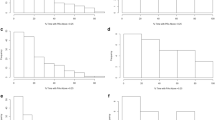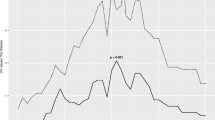Abstract
Introduction
Secondary brain injury due to increased intracranial pressure (ICP) contributes to post-traumatic morbidity and mortality. Although it is often taught that increased ICP begins early after traumatic brain injury, some patients develop increased ICP after the first 3 days post-injury. We examined our data to describe temporal patterns of increased ICP.
Methods
This is a retrospective review of prospectively collected physiologic and demographic data.
Results
Seventy-seven patients were included. We identified four patterns of increased ICP: beginning within 72 h (early), beginning after 72 h (late), early increases with resolution, and then a second rise after 72 h (bimodal), and continuously increased ICP. Late increases in ICP occur in 17% of this cohort. Peak day of swelling was day 7 for the “late” rise group and day 4 for the other patients with increased ICP. Forty-four percent of patients showed enlargement of cerebral contusions on follow-up imaging at 24 h post-injury.
Conclusions
Late rises in ICP were not rare in this cohort. This is clinically relevant as it may impact decisions about ICP monitor removal. Differences between groups in age, CT patterns of injury, fluid therapy, osmotic use, and fever were not statistically significant.


Similar content being viewed by others
References
Rutland-Brown W, Langlois JA, Thomas KE, Xi YL. Incidence of traumatic brain injury in the United States, 2003. J Head Trauma Rehabil. 2006;21:544–8. doi:10.1097/00001199-200611000-00009.
Maas AI, Stocchetti N, Bullock R. Moderate and severe traumatic brain injury in adults. Lancet Neurol. 2008;7:728–41. doi:10.1016/S1474-4422(08)70164-9.
Johnston IH, Johnston JA, Jennett B. Intracranial-pressure changes following head injury. Lancet. 1970;2:433–6. doi:10.1016/S0140-6736(70)90054-1.
Adams JH. Head injury in Greenfield’s neuropathology. 5th ed. London: Edward Arnold; 1992.
Bratton SL, Chestnut RM, Ghajar J, et al. Guidelines for the management of severe traumatic brain injury. J Neurotrauma. 2007;24(Suppl 1):S91–5.
Marshall LF, Marshall SB, Klauber MR, et al. A new classification of head-injury based on computerized-tomography. J Neurosurg. 1991;75:S14–20.
Marmarou A, Anderson RL, Ward JD, et al. Impact of Icp instability and hypotension on outcome in patients with severe head trauma. J Neurosurg. 1991;75:S59–66.
Unterberg A, Kiening K, Schmiedek P, Lanksch W. Long-term observations of intracranial pressure after severe head injury. The phenomenon of secondary rise of intracranial pressure. Neurosurgery. 1993;32:17–23; discussion 23–4.
Kohta M, Minami H, Tanaka K, Kuwamura K, Kondoh T, Kohmura E. Delayed onset massive oedema and deterioration in traumatic brain injury. J Clin Neurosci. 2007;14:167–70. doi:10.1016/j.jocn.2006.01.042.
Stocchetti N, Colombo A, Ortolano F, et al. Time course of intracranial hypertension after traumatic brain injury. J Neurotrauma. 2007;24:1339–46. doi:10.1089/neu.2007.0300.
Clifton GL, Miller ER, Choi SC, Levin HS. Fluid thresholds and outcome from severe brain injury. Crit Care Med. 2002;30:739–45. doi:10.1097/00003246-200204000-00003.
Madigan MC, Kemp CD, Johnson JC, Cotton BA. Secondary abdominal compartment syndrome after severe extremity injury: are early, aggressive fluid resuscitation strategies to blame? J Trauma. 2008;64:280–5.
Francony G, Fauvage B, Falcon D, et al. Equimolar doses of mannitol and hypertonic saline in the treatment of increased intracranial pressure. Crit Care Med. 2008;36:795–800.
Battison C, Andrews PJD, Graham C, Petty T. Randomized, controlled trial on the effect of a 20% mannitol solution and a 7.5% saline/6% dextran solution on increased intracranial pressure after brain injury. Crit Care Med. 2005;33:196–202. doi:10.1097/01.CCM.0000150269.65485.A6.
Ware ML, Nemani VM, Meeker M, Lee C, Morabito DJ, Manley GT. Effects of 23.4% sodium chloride solution in reducing intracranial pressure in patients with traumatic brain injury: a preliminary study. Neurosurgery. 2005;57:727–36; discussion 727–36.
Kaufmann AM, Cardoso ER. Aggravation of vasogenic cerebral edema by multiple-dose mannitol. J Neurosurg. 1992;77:584–9.
Mirski AM, Denchev ID, Schnitzer SM, Hanley FD. Comparison between hypertonic saline and mannitol in the reduction of elevated intracranial pressure in a rodent model of acute cerebral injury. J Neurosurg Anesthesiol. 2000;12:334–44. doi:10.1097/00008506-200010000-00006.
Shackford SR, Bourguignon PR, Wald SL, Rogers FB, Osler TM, Clark DE. Hypertonic saline resuscitation of patients with head injury: A prospective, randomized clinical trial. J Trauma Inj Infect Crit Care. 1998;44:50–7. doi:10.1097/00005373-199801000-00004.
Narayan RK, Maas AI, Marshall LF, Servadei F, Skolnick BE, Tillinger MN. Recombinant factor VIIA in traumatic intracerebral hemorrhage: results of a dose-escalation clinical trial. Neurosurgery. 2008;62:776–86; discussion 86–8. doi:10.1227/01.neu.0000316898.78371.74.
Narayan RK, Maas AI, Servadei F, Skolnick BE, Tillinger MN, Marshall LF. Progression of traumatic intracerebral hemorrhage: a prospective observational study. J Neurotrauma. 2008;25:629–39. doi:10.1089/neu.2007.0385.
Czigner A, Mihaly A, Farkas O, et al. Kinetics of the cellular immune response following closed head injury. Acta Neurochir (Wien). 2007;149:281–9. doi:10.1007/s00701-006-1095-8.
Dostal PCV, Parizkova R. Sepsis: cause of late deterioration of intracranial pressure in patients with severe traumatic brain injury? Crit Care. 1998;2:P061.
Zanier ER, Ortolano F, Ghisoni L, Colombo A, Losappio S, Stocchetti N. Intracranial pressure monitoring in intensive care: clinical advantages of a computerized system over manual recording. Crit Care. 2007;11:R7. doi:10.1186/cc5155.
Hochberg Y. A sharper Bonferroni procedure for multiple tests of significance. Biometrika. 1988;75:800–3.
Acknowledgments
The findings of this study do not necessarily represent the views of The Queen’s Medical Center. Sources of financial and material support: Queen Emma Research fund RA-2005-055.
Author information
Authors and Affiliations
Corresponding author
Rights and permissions
About this article
Cite this article
O’Phelan, K.H., Park, D., Efird, J.T. et al. Patterns of Increased Intracranial Pressure After Severe Traumatic Brain Injury. Neurocrit Care 10, 280–286 (2009). https://doi.org/10.1007/s12028-008-9183-7
Received:
Accepted:
Published:
Issue Date:
DOI: https://doi.org/10.1007/s12028-008-9183-7




